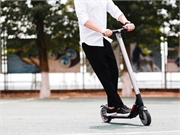ER Visits for E-Scooter Injuries Nearly Double in One Year
By Steven ReinbergHealthDay Reporter

MONDAY, Aug. 31, 2020 (HealthDay News) -- As the popularity of electric scooters has accelerated in the United States, so have serious injuries, which nearly doubled in just one year, a new study reveals.
In 2019, more than 29,600 e-scooter riders were treated in U.S. emergency rooms, up from about 15,500 the year before, the researchers found.
"I probably operate on at least two to three people that have scooter injuries every month, especially during the summer months," said study co-author Dr. Eric Wagner, director of upper extremity surgery research at Emory University, in Atlanta.
"These injuries are increasing and they aren't benign. Many of them are fractures, many of them are head injuries, and some of the head injuries require hospital admission, which means that they're very severe," Wagner said.
The study authors noted that only a minority of riders wear helmets and that riders often misunderstand traffic laws governing e-scooter use.
Wagner's team found that from 2014 to 2019, more than 70,000 e-scooter riders sustained injuries severe enough to warrant a trip to a U.S. emergency department. The number was less than 5,000 in 2014, before the convenient, environmentally friendly vehicles really took off.
E-scooters look like toys, but they're not, said Dr. Amishav Bresler, from the department of otolaryngology-head and neck surgery at Rutgers New Jersey Medical School, in Newark.
"A lot of people are really unaware how dangerous they can be," said Bresler, who wasn't involved in the study.
"I see many broken bones. Patients end up in the ICU due to being thrown off the scooter and hitting the ground at high velocity. So they can be even life-threatening, causing concussions, skull fractures, even brain bleeds," Bresler said.
Men aged 15 to 39 accounted for the greatest increase in injuries, the study findings showed.
When looked at from a population standpoint, e-scooter injuries rose from less than two per 100,000 people in 2014 to nine per 100,000 in 2019, the researchers found.
Of all injuries, 27% were to the head. And half of these were classified as a traumatic brain injury, which can include concussions and skull fractures. Many who had head injuries also suffered internal organ injuries, fractures, breathing difficulties or bleeding.
Among patients with a potential traumatic brain injury, 17% were admitted to the hospital, compared with 8% of patients without a head injury, according to the report.
Drugs and booze played a role in many scooter accidents in 2019, with over 2,600 injuries associated with use of these substances and 88% of these scooter crashes involving alcohol use.
For the study, the researchers used data from the U.S. National Electronic Injury Surveillance System.
Dr. Robert Glatter, an emergency medicine physician at Lenox Hill Hospital in New York City, agreed that people underestimate the dangers of e-scooters and their potential speed.
"This is even more relevant for older persons who choose to hop on these scooters, since they may have prolonged reaction times along with reduced dexterity and balance, thus increasing the risk of potential injuries and death," said Glatter, who had no role in the study.
Regarding the many accidents involving drug or alcohol use, Glatter said, "operating an e-scooter under the influence of drugs and alcohol … is a recipe for disaster."
Glatter also said pedestrians should remember to look both ways when crossing streets, noting riders weave in and out of traffic on streets and sidewalks.
"I have taken care of a number of pedestrians seriously injured in collisions with people operating e-scooters," he said. "Many have sustained head injuries, lacerations, concussions, internal organ injuries and extremity fractures."
E-scooters are a growing public health problem as their popularity continues to increase, Glatter warned.
Dedicated bike lanes in cities have helped to make a space for these riders, but Glatter said that's not enough.
"Increased regulations are necessary to protect citizens from the dangers associated with this new mode of transportation. This includes mandatory helmet use, enforcement of laws against operating them under the influence of drugs and alcohol, and a requirement that all riders take a safety course before operating them," he said.
The report was published online Aug. 31 in JAMA Network Open.
More information
The American Academy of Family Physicians has more about head injuries.

The news stories provided in Health News and our Health-E News Newsletter are a service of the nationally syndicated HealthDay® news and information company. Stories refer to national trends and breaking health news, and are not necessarily indicative of or always supported by our facility and providers. This information is provided for informational and educational purposes only, and is not intended to be a substitute for medical advice, diagnosis, or treatment.

